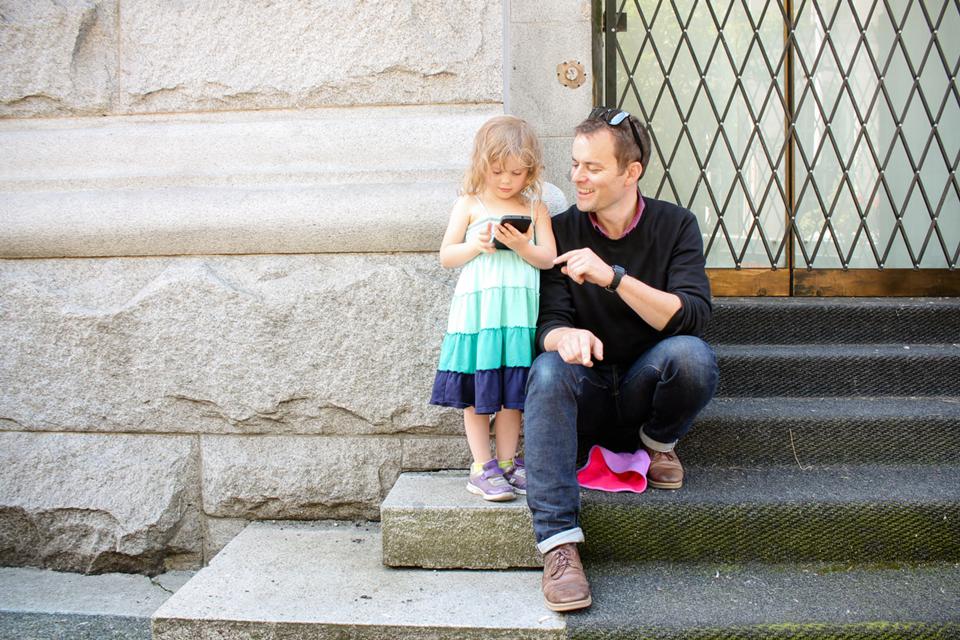Last Sunday I was in a parking lot behind the Stamps Place social housing complex, walking with my four-year-old back and forth between the dumpsters and some murals, trying to watch for cars while coaxing a fritzy ball on my phone screen to deliver the creature that was supposed to be inside. I was unsure what I was doing there, and so were some other people watching us.
The night before I had discovered I could install the as-yet unreleased Pokémon Go game on my phone, and for once I was happy when my daughter woke me up in the morning.
We loaded the app, which first made us decide on hair colour for our in-game character -- she chose purple. Then the phone’s screen shifted to a live stream of the bedspread behind it, except now a small, assertively cute monster was standing on it.
This was a Pokémon, the adorableness of which is of the particular sort that Japanese pop culture has been refining for decades. We were invited to capture it by flicking a little ball on the screen. Next up was a three dimensional map, with our purple-haired stand-in at the centre.
The map wasn’t a fantasyland. It was a recognizable grid of streets and building footprints belonging to a stylized Vancouver. But there were some fantasy bits as well, including a spinning tower structure just around the corner, next to the our local elementary school.
Pointing the phone towards the horizon revealed a number of these towers spread out in the hazy, pixelated distance. Closer to home there were some smaller virtual signposts, but there was no way to bring any of these objects towards us on the screen. In Pokémon Go you have to walk there in the real world to find the creatures and add them to your collection. We got some breakfast and her scooter and stepped out.
I was curious whether the creature-capturing gameplay would justify the hype I was seeing on social media. But as we wandered, I decided the moment of capture isn’t really the point. I’ve got a few routine routes through my neighbourhood and a handful of go-to local landmarks, and that usually feels like enough. The game’s injection of some algorithmic spontaneity immediately scrambled that sense of my familiar locale, which was a good feeling.
Here’s how it works: the map lets you know if any Pokémon creatures are nearby, and roughly how far away they are. Then it’s a warmer-colder process to try and get close enough to flush them into virtual view on the screen.
The locations of the creature “species” aren’t random, or at least not entirely. It seems there’s actually some very advanced map processing going on, what Dr. Renee Sieber of the McGill geography department calls “McHargian overlay.”
“Pokéman Go’s creators are using ‘Design with Nature’ approaches, looking for features like water or forested areas on maps and choosing where to place creatures based on those attributes. It’s got to be an enormously sophisticated computation,” Sieber says.
Within 200 metres of our house the game led us next to a butterfly garden that, for some reason, we had never visited. I was moving my phone around trying to triangulate on a variety of preternaturally cute rat, and my daughter was shrieking after a totally non-virtual hummingbird spotted darting into a tree. There were flowers to collect from the grass, pollinators to watch and the promised butterflies. Good things for a Sunday morning. The truth is we never would have been there if not for the virtual rat.
Leaving the garden we clicked on a nearby blue signpost and it showed us an image of a jazzy mural painted on the side of a shipping container. It was a clue to help us look for a “PokéStop” where we could collect more of the capture balls. We wandered towards it, leaving part of the Stamps Place social housing complex that we often cut through and heading into a less-visited parking area overlooked by the Hastings overpass. There was the mural, and the balls, and then suddenly a “zubat,” which we chased around the parking lot.
Other people were there using the area for their own, non-Pokémon purposes and we were drawing some attention. Stamps Place is majority-minority and we were conspicuously white, which might have been part of the reason, or maybe it was just our behaviour. In any case I started to feel weird using up someone else’s customary space for own unexplained purposes and we moved along.
Since that morning Pokémon Go use in Canada has been climbing towards the phenomenon-level engagement in the U.S. That activity will surely drop off in weeks or months to come. But it seems likely that augmented reality is, from this month onward, a part of our lives.
I might enjoy the change that can bring to my relationship to my neighbourhood, but it would be wrong to think those changes are neutral, or neutrally distributed. The nature of your new experience is going to depend, to at least some extent, on who you are, and where you are playing.
Augmented reality, but whose reality?
According to Sieber, algorithms may be making the choices about where to place the creatures and clues, but “even when algorithm driven, they’re driven by human nature... they’re built by white guys, white straight guys. The data comes from Ingress, Google’s earlier effort at an AR [augmented reality] game. The game chooses where to put virtual objects based on where the kinds of people who played Ingress would go. Any biases embedded in Ingress have come over with it.”
Sieber is concerned about a new kind of augmented-reality-boosted redlining, guiding people away from certain areas, and maybe toward others.
“It could be [Pokémon Go publisher] Niantic stopping people from playing in the Holocaust Museum, who could argue with that? but what if Niantic doesn’t want to expose people to social housing? [Niantic CEO] John Hanke says he wants to promote walking and seeing your neighbourhood, but what about indigenous spaces? What if Hanke thinks white people should be interested in that, but indigenous people from Kahnawake or Kanesatake don’t want that?”
Every PokéStop has a little description associated with it. The closest PokéStop to my house is described like this:
“Joining the Keefer St. Walkway, the arch guards all who pass through its portal.”
How is it that possible? How can a game that hasn’t even been released in Canada have some kind of themed travelogue embedded all around me?
The answer apparently is that those descriptions have been copied from Ingress, the earlier game Sieber mentioned. Ingress was built by Niantic when it was still a part of Google. Ingress never attracted the crowds that Pokémon has, and it’s possible the new game reflects the distribution and preferences of its limited user base.
Twitter user @KendraJames thinks she spotted that effect while taking a bus ride through Irvington, New Jersey.
Virtual game, real-world consequences
There are already plenty of stories about how these AR shaping influences -- demographic, systemic, algorithmic -- are reflecting back into the real word. They’re affecting the foot traffic that is the lifeblood of local businesses. They’re leading to ambiguous interactions that are in danger of escalating in dangerous ways.
And they’re helping people feel more connected to the places they’ve long lived in. I met Erik Freisen on Twitter the night after my first neighbourhood walk. He’s a geospatial analyst in Dallas.
I asked him what it’s like playing in a multi-racial city living through a fraught moment, when relationships between communities and law enforcement are surely tense.
“I’ll typically go out after my wife goes to bed and I’ll be wandering through all sorts of neighbourhoods. I won’t typically let myself go near ones that are dangerous or anything, but I'm seeing neighbourhoods I haven’t been in much before… It’s also been interesting the age differences I’ve run across. Even very late at night I’ve run across people who are clearly retirement age, and because it’s summer I’ve run across tweens who are excited to see adults out playing too, and it’s well into the night.
That first night out, I ran into a younger hispanic couple, a guy teaching his girlfriend to play, and another hispanic guy comes up and starts talking to us, and he looks about 10 years older than me, and a couple of black guys came and we all started hanging out. When the police came around and saw the group I immediately tensed up but they were really cool.”
Beyond algorithms, that may be another factor that determines how augmented reality augments, or doesn’t, your reality: the disposition of your local law enforcement.
“The Dallas Police Department are actually one of the better police departments as far as community relations goes. I definitely saw that in action. They were really cool, didn’t even come up in an accusatory fashion. They asked ‘hey are you guys playing Pokémon’ and kind of started playing with us.”
The tower spinning beside the school across the street has changed colours four times in the past four days. This mostly seems to happen overnight, which presumably means that someone has been visiting while we’ve been sleeping, and doing things with their phone to claim or reclaim it.
That makes for yet another flavour of nocturnal visitor, joining the teenagers who climb up on the school roof to hang out, and whoever it is that collects random stuff from our front room when we leave the screen door unlocked.
I’m curious how they will get along, and if I might now have a reason to meet them. ![]()
Read more: Science + Tech, Urban Planning + Architecture
















Tyee Commenting Guidelines
Comments that violate guidelines risk being deleted, and violations may result in a temporary or permanent user ban. Maintain the spirit of good conversation to stay in the discussion.
*Please note The Tyee is not a forum for spreading misinformation about COVID-19, denying its existence or minimizing its risk to public health.
Do:
Do not: